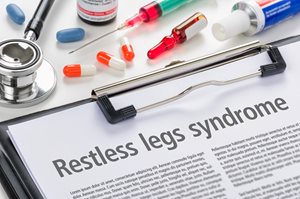 For years, Edwin enjoyed spending his evenings relaxing in his recliner with a good book in his hand and quiet music playing on the radio. Now, at age 84, something was interrupting his nightly ritual, and it was affecting his ability to sleep as well. Almost nightly, Edwin would feel an odd sensation in his legs. It distracted him and made him unable to concentrate on his book. The only thing that seemed to relieve the problem was getting up and moving around. When Edwin mentioned it to his daughter, she insisted he tell his doctor about it. Edwin’s doctor diagnosed him with restless leg syndrome (RLS). Edwin and his daughter knew nothing about the condition and wondered what had caused it.
For years, Edwin enjoyed spending his evenings relaxing in his recliner with a good book in his hand and quiet music playing on the radio. Now, at age 84, something was interrupting his nightly ritual, and it was affecting his ability to sleep as well. Almost nightly, Edwin would feel an odd sensation in his legs. It distracted him and made him unable to concentrate on his book. The only thing that seemed to relieve the problem was getting up and moving around. When Edwin mentioned it to his daughter, she insisted he tell his doctor about it. Edwin’s doctor diagnosed him with restless leg syndrome (RLS). Edwin and his daughter knew nothing about the condition and wondered what had caused it. About RLS
RLS is a condition that can affect a person at any age, but it usually gets worse as a person ages. The primary symptom of RLS is an odd sensation in the legs that makes the person feel like they must move. People often describe the feeling as:
- Crawling.
- Itching.
- Electric.
- Pulling.
- Throbbing.
- Creeping.
- Aching.
Causes of RLS
Much of the time doctors are unable to pinpoint a cause of RLS. Some research suggests that the problem might be related to a chemical in the brain called dopamine. Dopamine is responsible for transmitting the messages that control muscle movement. Other research suggests that there may be a hereditary factor to RLS as it does run in families, particularly when it starts before the person turns 40.
Sometimes chronic conditions, like Parkinson’s disease and kidney failure, may lead to RLS or make RLS worse. Certain medications can also make the symptoms of RLS worsen.
RLS can be treated with medication. There are also some lifestyle changes and home remedies that can help. Some things family caregivers and elder care providers can try to help a senior with RLS are:
- Warm bath.
- Massage.
- Hot or cold packs.
- Using relaxation techniques, like meditation or yoga.
- Exercise.
Sources
https://www.webmd.com/brain/restless-legs-syndrome/restless-legs-syndrome-rls#1
https://www.mayoclinic.org/diseases-conditions/restless-legs-syndrome/symptoms-causes/syc-20377168
https://www.medicalnewstoday.com/articles/7882.php
If You Or An Aging Loved One Are Considering Hiring Elder Care in Delray Beach, FL, Please Contact The Caring Staff At BrightStar Care Today! 561-921-0550.
